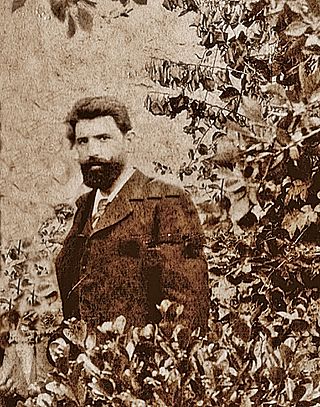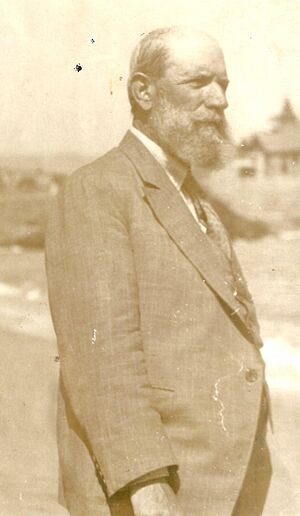Vicente Medina facts for kids
Quick facts for kids
Vicente Medina
|
|
|---|---|

Vicente Medina on the right of the group, with black beard
|
|
| Born | 27 October 1866 Archena, Spain |
| Died | 17 August 1937 (aged 70) Rosario, Santa Fe, Argentina |
| Resting place | Cementerio de la Piedad, Rosario, Santa Fe |
| Occupation | Poet, Dramatist |
| Language | Spanish |
| Nationality | Spanish |
| Period | 1895–1932 |
| Notable works | Aires murcianos (1898) |
Vicente Tomás Medina (born October 27, 1866 – died August 17, 1937) was a Spanish poet and dramatist (a writer of plays). He was also an editor. Vicente Medina became a symbol of local identity for the Murcia region in southeastern Spain.
His most famous work is Aires murcianos (which means "Murcian Airs"). This book became very important for understanding the culture and society of the area. Other writers at the time praised it a lot. During his life, many people in Spain thought Medina was one of the country's most important writers. They even called him "the great contemporary Spanish poet." Today, fewer people read his works. However, he is still known as the most important poet to write in the Murcian dialect. A dialect is a special way of speaking a language in a certain area.
Contents
Life and Early Works
Growing Up in Archena
Vicente Medina was born in 1866 in Archena, a small spa town. A spa town is a place known for its special water that people believe is good for health. Archena is about 25 kilometers from the city of Murcia.
His mother worked as a dressmaker. His father, Juan de Dios Medina, owned a small business. Juan de Dios loved books and art very much. He ran a shop at the Archena spa. This is where young Vicente got to read books by famous writers. He read authors like Gustavo Adolfo Becquer, José de Espronceda, Victor Hugo, and Emile Zola.
Time in the Army and Return Home
After some time in the army, Vicente Medina traveled to the Philippines. He wrote his first poems while he was there. In 1890, he came back to the Murcia region. He settled in the port city of Cartagena. There, he found a job with a company that published two local newspapers.
The next year, he married Josefa Sanchez Vera in Archena. The couple then moved back to Cartagena to live. Medina became active in the city's writing groups. He published works with other writers in local magazines. He also spent time with Bartolomé Pérez Casas and his cousin Inocencio Medina Vera. Most importantly, he became close friends with José García Glass, who became his mentor. A mentor is someone who guides and advises a younger person.
Literary Achievements
First Steps to Success
Medina's first important poem was "El Náufrago" (The Shipwrecked) in 1895. However, he later said he didn't like this poem much. He found greater success with his first play. He was inspired to write it because of how local language was used. People often used the local Murcian Spanish dialect in funny ways during Carnival celebrations. Medina wanted to write a serious play using this local dialect.
The play was called El Rento, and it was first performed in 1898. Important critics from all over Spain liked it a lot. Famous writers like Miguel de Unamuno and Clarín also praised it. This positive response encouraged Medina to explore writing more in the local dialect.
Aires Murcianos and Its Impact
Medina collected the poems he had written while preparing for El Rento. He published them as Aires murcianos. This book became his most famous and successful work. It looked at the lives of the poorest people in Murcia's countryside. The book combined social criticism with creative use of the local language.
A famous critic named Azorín wrote about it. He said that even if Medina wrote nothing else, Aires murcianos would be "enough to place [him] among the great poets." This shows how important his work was considered at the time.
Life in Argentina and Final Years
Moving to Argentina
In 1905, Medina moved to Argentina. Several of his family members had already moved there. He continued to work as a writer and editor. He edited a literary magazine called Letras. In 1915, during the First World War, he published an anti-war poem. It was called La Canción de la guerra (The Song of War).
Return to Spain and Final Journey
Medina came back to Murcia in 1931. He released his last book there, called Belén de pastores y villancicos. However, the Spanish Civil War was about to begin. People advised him to return to Argentina for his safety. He was already ill when he went back in 1936. He passed away in 1937 in Rosario, Santa Fe, Argentina. He is buried there at the Cemetery of La Piedad.
Selected Works
Poetry Collections
- Aires murcianos (1898)
- Alma del Pueblo (1900)
- La Canción de la vida (1902)
- La Canción de la guerra (1915)
- Abonico (1917)
- ¡Allá Lejicos! (1928)
Plays (Drama)
- El Rento (1898)
- ¡Lorenzo! (1899)
- El Alma del Molino (1902)
Images for kids
See also
 In Spanish: Vicente Medina para niños
In Spanish: Vicente Medina para niños



